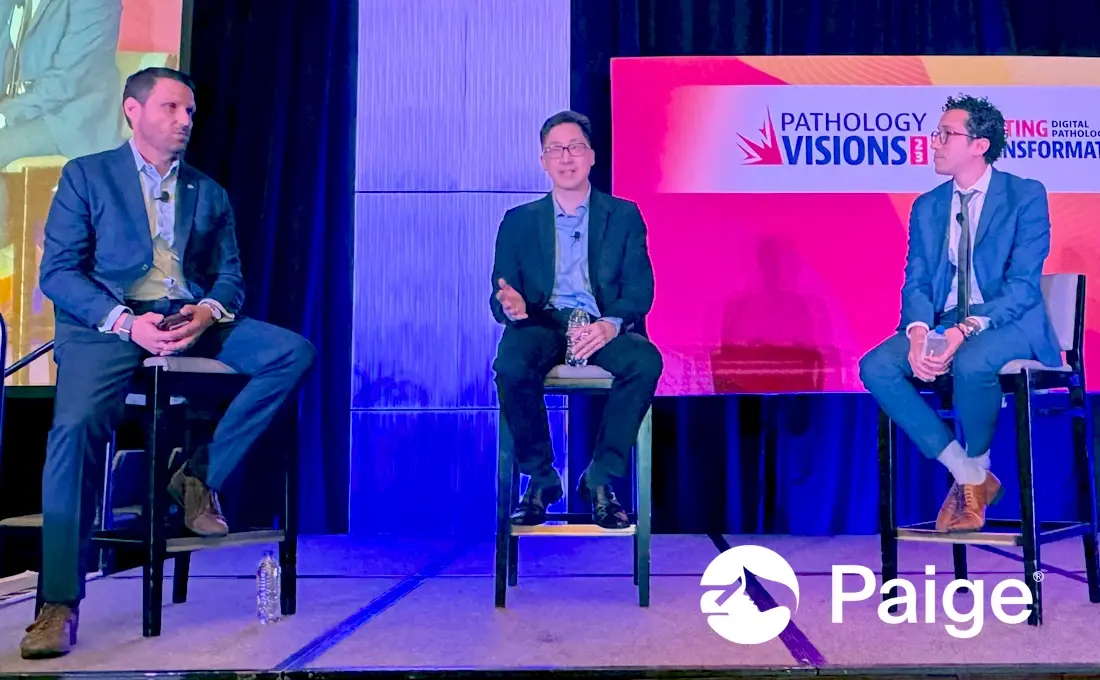The Future of Diagnosis Unveiled in a Fireside Chat with Industry Leaders
In a dynamic fireside chat preceding the 2023 Pathology Visions Conference, industry giants Microsoft and Paige unveiled their vision for the future of digital pathology and shed light on the pivotal role of cloud computing and AI technology for the field.
The meeting of minds featured Dr. David Rhew, Global Chief Medical Officer at Microsoft, Andy Moye, CEO of Paige, and Razik Yousfi, Senior Vice President of Technology at Paige. Together, they explored how cloud computing and AI are poised to reshape the field of digital pathology in profound ways.
Dr. Rhew set the stage by emphasizing that the transformation has already begun, with cloud computing gradually infiltrating healthcare institutions over the past decade. However, it has recently gained momentum, especially in larger organizations who have been struggling with legacy systems that have been unable to match the scale and speed of innovation. Cloud computing offers a cost-effective solution while enabling labs to harness the power of digital pathology, which has advanced significantly in recent years.
Further, cloud technology presents direct solutions to challenges inherent in on-premise systems. The size of pathology imaging makes it challenging to plan for the next 5-10 years with traditional storage and systems. With cloud technology, scalability is inherent, allowing laboratories to adopt digital pathology swiftly and facilitating growth as they mature digitally. Cloud systems are also updated seamlessly, relieving labs of the burdensome task of manual updates and ensuring their systems remain up-to-date over time. Cloud solutions, by nature, are remote-ready, enabling easy image sharing and fostering collaboration across various departments, health systems, and geographic locations. This inherent flexibility improves overall organizational efficiency.
Dr. Rhew emphasized the cost-effectiveness and security provided by cloud solutions. Labs pay only for what they use, eliminating the need for large upfront investments and ongoing maintenance costs. Security, a paramount concern in healthcare, is also addressed and fortified by the best-in-class standards and robust teams responsible for building these cloud infrastructures.
However, the true game-changer is the integration of AI into pathology. Razik explained that with cloud solutions, pathologists can leverage Paige’s AI applications. Backed by extensive datasets, these tools empower pathologists to extract more information from tissue images, aiding in the detection and diagnosis of cancer. The applications have received approval from regulatory bodies such as the FDA, highlighting their safety and effectiveness.
Microsoft is taking AI to the next level by introducing multi-modal AI, which combines data from images, electronic health records, genomic profiling, and more. This novel approach provides physicians with a holistic view of cellular-level insights, fostering improved diagnoses.
Together, Microsoft and Paige are also collaborating on building the world’s largest computer vision model, known as a Foundation Model. This model leverages data from different institutions and diverse staining techniques along with billions of parameters to deepen our understanding of cancer morphology and can accelerate AI adoption in pathology by supporting the development of novel applications, such as those for identifying rare cancers, for the benefit of pathologists and patients alike.
Dr. Rhew and Razik stressed the importance of deploying AI responsibly. Transparency, data sources, and safety testing are critical factors that organizations must consider when implementing AI. Further, pathologists must remember that these tools are designed to enhance their work by automating repetitive tasks and providing valuable insights, not to ever replace them.
In closing, the experts offered guidance for pathologists considering cloud computing and AI adoption. First, communication with organizational leadership is key to tapping into existing cloud infrastructure or aligning with future strategic plans that could benefit pathology departments. Additionally, don’t be deterred by common IT challenges, as solution providers offer tools to streamline adoption. Selecting trusted vendors who simplify IT challenges is essential and embracing these technologies positions pathologists as leaders in the evolving field of digital pathology.
The future of pathology promises to be more efficient, accurate, and accessible than ever before, thanks to the synergistic potential of AI and cloud computing. Microsoft and Paige are at the forefront of this transformative journey, and their insights are set to revolutionize the field of digital pathology.

